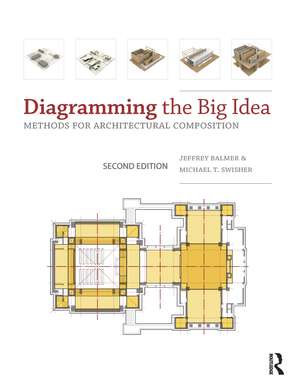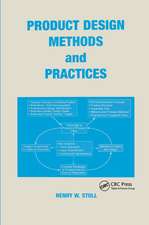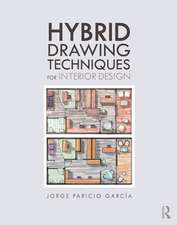Diagramming the Big Idea: Methods for Architectural Composition
Autor Jeffrey Balmer, Michael Swisheren Limba Engleză Hardback – 3 iul 2019
In Diagramming the Big Idea, Jeffrey Balmer and Michael T. Swisher introduce the fundamentals of design thinking by illustrating how architects make and use diagrams to clarify their understanding of both specific architectural projects and universal principles of form and order. With accessible, step-by-step procedures that interweave diagrams, drawings and virtual models, the authors demonstrate how to compose clear and revealing diagrams.
Design thinking defines a method for engaging the world through observation and analysis. Beyond problem solving, design is a search for possibilities. Mastering design thinking begins with learning the fundamentals of visual composition. It embraces the ability to synthesize deductive and imaginative reasoning, combining both shrewd scrutiny and fevered speculation.
Design diagrams make visible the abstractions that order the built environment. Premised upon the Beaux-Arts notion of the architectural parti, Balmer and Swisher adopt the ‘Big Idea’ as a foil and as a suitcase to organize fundamentals of architectural composition. The goal of this book is to make explicit to students what they are learning, why they are learning it and how to internalize such lessons toward their lifelong development as designers.
| Toate formatele și edițiile | Preț | Express |
|---|---|---|
| Paperback (1) | 321.92 lei 6-8 săpt. | |
| Taylor & Francis – 4 feb 2019 | 321.92 lei 6-8 săpt. | |
| Hardback (1) | 780.94 lei 6-8 săpt. | |
| Taylor & Francis – 3 iul 2019 | 780.94 lei 6-8 săpt. |
Preț: 780.94 lei
Preț vechi: 1037.24 lei
-25% Nou
Puncte Express: 1171
Preț estimativ în valută:
149.43€ • 156.03$ • 123.40£
149.43€ • 156.03$ • 123.40£
Carte tipărită la comandă
Livrare economică 15-29 aprilie
Preluare comenzi: 021 569.72.76
Specificații
ISBN-13: 9781138549890
ISBN-10: 1138549894
Pagini: 330
Ilustrații: 25 Line drawings, color; 945 Line drawings, black and white; 70 Halftones, color; 110 Halftones, black and white
Dimensiuni: 210 x 280 x 19 mm
Greutate: 1.38 kg
Ediția:2 New edition
Editura: Taylor & Francis
Colecția Routledge
Locul publicării:Oxford, United Kingdom
ISBN-10: 1138549894
Pagini: 330
Ilustrații: 25 Line drawings, color; 945 Line drawings, black and white; 70 Halftones, color; 110 Halftones, black and white
Dimensiuni: 210 x 280 x 19 mm
Greutate: 1.38 kg
Ediția:2 New edition
Editura: Taylor & Francis
Colecția Routledge
Locul publicării:Oxford, United Kingdom
Public țintă
Postgraduate and UndergraduateCuprins
Part I: Setting the Stage
1. Introduction
Read me first!
Why read this book?
What is architecture?
Organization, order, composition
Utility, function, purpose
Measure & matter
Design & method
Strategies & tactics
The structure of the narrative
The sequence of the chapters
The role of precedents
The point of departure
Glossary of terms
Diagrams as method
Diagram types
Diagramming & design education
Learning diagrammatic form
Gestalt sub–categories
The diagram & visual order
Our purpose
Glossary of terms
On order
On measure
Dividing the square
Rules of engagement
Positive & negative space
Order & the orthogonal
Glossary of terms
4. Design & drawing fundamentals
On drawing
Relevance to design
Deriving order in drawing
Exercises in relational geometry
Defined & implied space
Analyzing the composition
Three variant compositions
Observing contrast, repetition, alignment & proximity
The variations considered
General observations
Motif, pattern & theme
Defined fields
Sorting through results
Implied fields
Adding fields
Combining fields
Summary
Glossary of terms
5. Building on proportion
Object on a field
A figure in the relational field
Looking at the groups
Selecting & analyzing an aggregate composition
Adding to the quadrants
Two elements
Refining the figures
Observing the new figures
Observing the new group
Glossary of terms
Drawing in the third dimension
Adding fields & overhead planes
Turning the grid
Reading the section
A final model
Glossary of terms
7. Starting in three dimensions
Design on a grid
The site
Three figures
Spatial models
Volume, form & space: an example
Visualizing connection with constructed axes
The gestural nexus
Spatial hierarchy: field grain & path
Clarifying plan elements
The new grid
Strategy set
Tactical definitions & variations
A final remark
Glossary of terms
More complex approaches to strategies
Strategy definitions
Tactical themes & variations
Tactics expanded – procedure & results
Three–dimensional diagrams
Combined diagram models
Planning the final model
Fragments models
The final model
Conclusion
Glossary of terms
9. Precedent diagrams in two dimensions
Introduction
Two concepts
Two expressions
Two dimensions
Two projects
House with Three Courts
The Danteum
Glossary of terms
Introduction
Representing the third dimension
Phillips Exeter Academy Library
Unity Temple
Diagram as generator
Glossary of terms
1. Introduction
Read me first!
Why read this book?
What is architecture?
Organization, order, composition
Utility, function, purpose
Measure & matter
Design & method
Strategies & tactics
The structure of the narrative
The sequence of the chapters
The role of precedents
The point of departure
Glossary of terms
- Details 1 - Order & Measure
From the divine to the secular - Demonstration 1.1
Organizational figures - Demonstration 1.2
The courtyard schema - Demonstration 1.3
Courtyards as objects - Demonstration 1.4
Additional courtyard schemata
Diagrams as method
Diagram types
Diagramming & design education
Learning diagrammatic form
Gestalt sub–categories
The diagram & visual order
Our purpose
Glossary of terms
- Details 2
Indigenous diagrams - Demonstration 2.1
Diagrams & contexts - Demonstration 2.2
Plan as diagram
On order
On measure
Dividing the square
Rules of engagement
Positive & negative space
Order & the orthogonal
Glossary of terms
- Details 3 - Order, Orientation, Orthogonal
The gridded city - Demonstration 3.1
Gestalt defined - Demonstration 3.2
Gestalt readings of basic form
4. Design & drawing fundamentals
On drawing
Relevance to design
Deriving order in drawing
Exercises in relational geometry
Defined & implied space
Analyzing the composition
Three variant compositions
Observing contrast, repetition, alignment & proximity
The variations considered
General observations
Motif, pattern & theme
Defined fields
Sorting through results
Implied fields
Adding fields
Combining fields
Summary
Glossary of terms
- Details 4 - The Courtyard
Figure–ground & solid–void - Demonstration 4.1.1
Figures & field in variation - Demonstration 4.1.2
Variation & elaborations - Demonstration 4.1.3
Variation & elaborations - Demonstration 4.2
Further variations - Demonstration 4.3
Contrast, repetition, alignment & proximity
5. Building on proportion
Object on a field
A figure in the relational field
Looking at the groups
Selecting & analyzing an aggregate composition
Adding to the quadrants
Two elements
Refining the figures
Observing the new figures
Observing the new group
Glossary of terms
- Details 5 - Figures & Fields
Objects & space - Demonstration 5.1
Regulating lines dividing space - Demonstration 5.2
Figures & their construction - Demonstration 5.3
Field, grain & path
Drawing in the third dimension
Adding fields & overhead planes
Turning the grid
Reading the section
A final model
Glossary of terms
- Details 6 - Axis & Path
Lines, planes & volumes
7. Starting in three dimensions
Design on a grid
The site
Three figures
Spatial models
Volume, form & space: an example
Visualizing connection with constructed axes
The gestural nexus
Spatial hierarchy: field grain & path
Clarifying plan elements
The new grid
Strategy set
Tactical definitions & variations
A final remark
Glossary of terms
- Details 7 - Spatial Systems
Frames, planes & cells - Demonstration 7.1
Axial volumes - Demonstration 7.2
Additional composition models
More complex approaches to strategies
Strategy definitions
Tactical themes & variations
Tactics expanded – procedure & results
Three–dimensional diagrams
Combined diagram models
Planning the final model
Fragments models
The final model
Conclusion
Glossary of terms
- Details 8 - Treshold & Boundary
Containment & connection - Demonstration 8.1
Axial volumes - Demonstration 8.2.1
Alternate tactical diagrams - Demonstration 8.2.2
Additional hybrid tactical diagrams - Demonstration 8.3
Demonstration model - Demonstration 8.4
Demonstration drawings - Demonstration 8.5.1
Assembly images - Demonstration 8.5.2
Alternate model #1 - Demonstration 8.5.3
Alternate model #2
9. Precedent diagrams in two dimensions
Introduction
Two concepts
Two expressions
Two dimensions
Two projects
House with Three Courts
The Danteum
Glossary of terms
- Details 9 - What an Architect Sees
Margaret Esherick house
Introduction
Representing the third dimension
Phillips Exeter Academy Library
Unity Temple
Diagram as generator
Glossary of terms
- Details 10 - The Language of Color
Color as a subject
Glossary of color terms
- Master glossary of terms
- Index
Notă biografică
Jeffrey Balmer and Michael T. Swisher are associate professors of architecture at the University of North Carolina at Charlotte.
Recenzii
‘Balmer and Swisher’s objective is to explore the orthogonal geometric frameworks essential to architectural design. It drives their teaching and was rigorously expounded in the first edition of Diagramming the Big Idea. It is expressed so much more clearly in this second edition. Explanatory text has been considerately revised and expanded. The number of examples and case studies has been increased. Interpretation of the many diagrams has been enhanced by the subtle use of colour. The clarion call remains powerful: architecture is a serious intellectual discipline.’
Simon Unwin, Emeritus Professor of Architecture, University of Dundee, Scotland
‘Diagramming the Big Idea was a tremendous help to me when first learning to teach beginning design. The book is full of useful techniques and processes that distill the basics of teaching architecture. The book continues to help me focus and target my teaching on foundational principles of the discipline.’
Sallie Hambright-Belue, Assistant Professor Clemson University, School of Architecture, USA
Simon Unwin, Emeritus Professor of Architecture, University of Dundee, Scotland
‘Diagramming the Big Idea was a tremendous help to me when first learning to teach beginning design. The book is full of useful techniques and processes that distill the basics of teaching architecture. The book continues to help me focus and target my teaching on foundational principles of the discipline.’
Sallie Hambright-Belue, Assistant Professor Clemson University, School of Architecture, USA
Descriere
In the second edition of Diagramming the Big Idea, Jeffrey Balmer and Michael T. Swisher illustrate how you can create and use diagrams to clarify your understanding of both particular projects and organizing principles and ideas.









